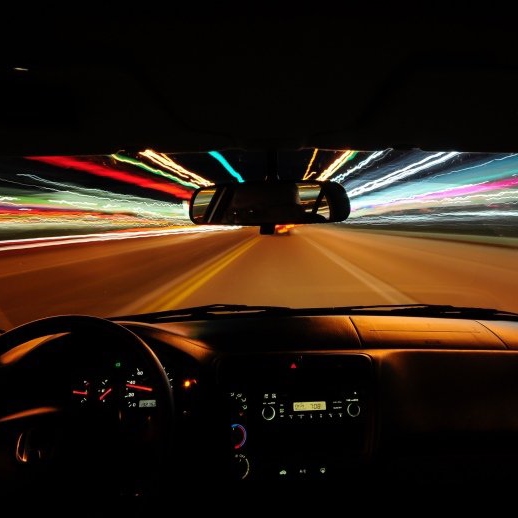In the dark, even a single vehicle can be intimidating. As the sun sets, there are a few things that can be scary like driving a dark road, with little protection from the elements, a lack of visibility and the possibility of unseen hazards on the street.
You may be struggling to drive at night because (1) You don’t have good headlights to see other vehicles clearly at night, (2) Your pupil dilates to allow in more light at night, which can cause more blurring and glares, and most importantly, (3) Nighttime driving is difficult because the glare from oncoming headlights makes it hard for you to see properly.
In the rest of the article, I will be talking about the challenges of nighttime driving, how to adopt safe driving at night and things to do to aid in seeing clearly at night if you choose to drive.
Why is night driving challenging for drivers?
Nighttime driving is different from daytime driving and is often treated as a separate category. The challenge of night driving, especially in a city, is that there is always the issue of reduced visibility, tiredness and hastiness. The road environment at night is not that much different from the day; the only thing that doesn’t change is that the road is still there. Most other things change, like the size of your mirrors, the distance you can see, and the types of hazards that you may encounter.
Driving at night can be difficult because you can’t see as well as during the day. It can be more dangerous because of the decreased visibility. And of course, darkness signals to your body that it’s time to sleep, which can affect your reaction time and ability to stay focused. Also coupled with the fact that many people are in a haste to beat time and reach home early.
When you are driving at night you should?
Driving at night is generally harder than driving during the day since your vision is more stretched. You can’t see as far and you have to adjust your speed. But how do you make out the best ways to manage your nighttime driving? Here are a few things you should do when you are driving at night:
- Maintain a slower speed to give you time for any action when there is an emergency.
- To manage night driving and ensure others on the road enjoy it, use your headlights sparingly at night, when possible.
- Use your high beams only when necessary, and be aware of oncoming traffic.
- Use low beams when you see an oncoming vehicle to prevent momentarily blinding the driver.
- Ensure your windshield and headlights are clean to reduce blurry glare and improve visibility.
- Keep your eyes on the road at all times and avoid unnecessary distractions.
- Stay calm and maintain firm control and grip on the wheels.
- Be extra cautious, alert and prepared for any sudden action.
- Look around your surroundings through the corner of your eyes to see where pedestrians are or other objects you might need to look out for when there is a need to take quick action.
- If you notice your headlights have become faulty and would give you more trouble seeing, park where is safe and find other means of going home.
How do you drive a vehicle safely at night time?
Driving at night is scary enough, but with a few tips here and there, you can keep a few things in mind that you can do to help ensure that you stay safe when you are on the road at night. Here are a few of them:
- For your own safety, you should use extra caution when driving at night, especially near busy intersections and in dense traffic.
- You should avoid drinking and using drugs while driving, as these activities can impair one’s ability to drive safely at night and even see clearly.
- Portable safety devices such as emergency flashers and turn signals can help drivers stay safe when driving at night.
- You should use your headlights as it would help to make it easier for you to see other vehicles and pedestrians in your lane. Therefore, when you are driving at night you should always have your headlights on.
- Having headlights that are well maintained is important. This can be done by checking the headlights regularly for cracks, making sure the headlights are in good working condition and making sure the vehicle battery is in good condition.
- Turn on your headlights at all times as headlights are a safety feature. They help to make you more visible to other vehicles and pedestrians.
- Watch out for pedestrians, bicycles, wildlife and other obstacles. This would help you know who or what to consider when there is a need for urgent action.
- Understand proper headlight safety to help you make the right usage. Know when to use high beams, low beams or even full headlights.
- Reduce your speed to compensate for limited visibility at night.
- Watch the right edge of your lane and the road, watch the centerline on the road and adjust your instrument lights.
What to do to aid night vision when driving
Driving in the dark can be a scary experience. Unless you have a vehicle equipped with a high-end, expensive night vision system, you’re forced to rely on your vision alone. It can be dangerous if you don’t know how to handle the situation. There are ways to make night driving easier, like using a headlight conversion kit or installing high-intensity discharge (HID) headlights. But, that would not give you all the assistance you need. So, what can you do to aid your night vision when driving? Here are a few things to try:
- While we may have many different ways to add night vision to our cars, nothing could be more important than the headlights themselves.
- The headlights on your vehicle are more than just light sources – they are an extension of your eyes and your brain. Your brain needs to be able to tell whether an object is closer or farther than it is, and that requires light. For this, never go out at night with one or no headlights!
- If you are experiencing difficulty seeing at night on the road, you may need to replace your headlight with high-powered light bulbs.
- Protect your eyes with an anti-glare glass while driving at night as this will save you from the problem of getting dazzled or momentarily blinded by other drivers.
- If you are experiencing difficulty seeing at night because of a vision problem, you may need to see an eye specialist
- Your age can also play a factor in your vision while driving at night. When you are way older and struggling with sight, try to avoid night driving if you can.
- If you are experiencing difficulty seeing at night because of a medical condition, you should consult your doctor immediately.
- Automotive headlights are a form of lighting that allows the vehicle driver to see the road in front of them. They are important for safe driving, especially at night. When this is absent, it becomes a problem for you while driving at night.
- Keeping your eyes on the road can be a challenge at night, but you have to accept that and maintain focus no matter what. If you feel tired or losing focus, park in a safe place and go home using another means.
Conclusion
Disclaimer
Hi, just letting you know that all products recommended here have been used by me, or are properly researched to ensure they are the best you are getting without bias.
I am also an affiliate for certain Amazon products and this means that some links here are affiliate links. If you purchase an item through any of them, I MAY earn a commission at no extra cost on you.


